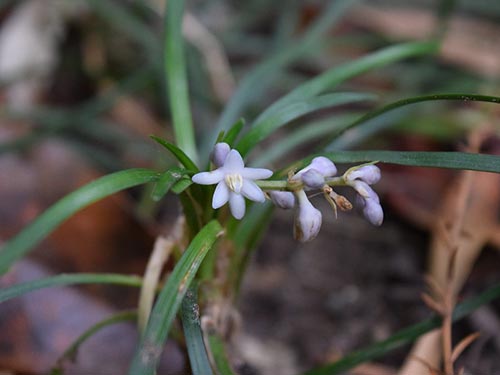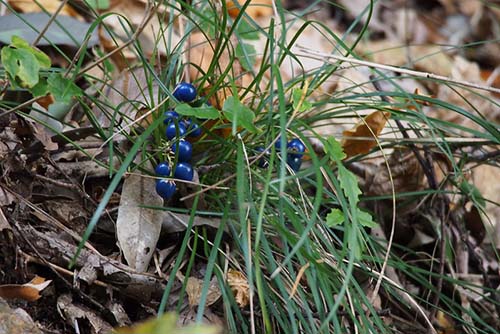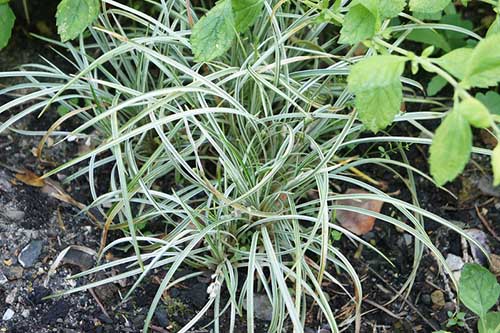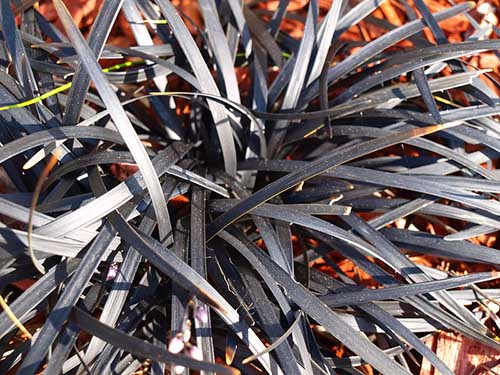I recently gave myself a challenge: to walk around my neighborhood looking at people’s gardens and see which plants have health benefits. This is what initially led me to Ophiopogon (aka mondo grass). Even though it is native to Asia, mondo grass is grown throughout the world. The humble plant has many surprising health uses, including suppressing cough, reducing inflammation and boosting immunity.
What Is Ophiopogon?
Ophiopogon is an evergreen plant originally from East Asia. It looks like tall, thick grass. Some subspecies have colorful blades, delicate flowers, and blue berries, so are popular ornamental ground cover. Even though it has a long history of medicinal use in China and Japan, Ophiopogon only recently started getting attention in the West for its health benefits.

Types of Ophiopogon
Ophiopogon is the name for the plant’s genus. There are many different species within this genus (Wikipedia lists 67 Ophiopogon species). The most popular species of Ophiopogon are:
Ophiopogon japonicas:
Of all the types of Ophiopogon, japonicas is the best known for health benefits. Most scientific studies on the plant also focus on the japonicas species. It has pretty flowers and blue fruits.

Ophiopogon japonicus ‘Variegata’:
Also called Silver Mist mondo grass because of the lines on its blades.

Ophiopogon japonicus ‘Nana’:
This variant is called dwarf mondo grass because it only grows to be about 6 inches tall.
Ophiopogon planiscapus ‘Nigrescens’:
This type of Ophiopogon is also known as black mondo grass because of its dark blades and pretty pink flowers. It grows to be about 12 inches tall.

Ophiopogon jaburan ‘Vittatus’:
Also called variegated mondo grass, this species is larger and more robust. The blades have yellow and green stripes going down them.
Other Names for Ophiopogon
Depending on the species and region, any of these names for Ophiopogon might be used.
- Mondo grass
- Dwarf mondo grass
- Black dragon grass
- Dragon’s beard grass
- Mai men dong
- Kokuryu
Note that you’ll sometimes hear the name lilyturf or monkey grass being used for Ophiopogon. While those plants look similar to Ophiopogon, they are actually members of the lily (Liliaceae) family and not the same as mondo grass. This is important if you plan on foraging mondo grass or want to grow it in your garden.
Health Benefits of Ophiopogon
In Chinese medicine, Ophiopogon is known as mai men dong. It has been used for thousands of years medicinally. It’s still popular today in natural medicine. There are thousands of scientific studies which support the many health benefits of Ophiopogon. Below I’ll go over the main benefits which are supported by scientific research.
1. Fighting Inflammation
Several anti-inflammatory components have been isolated from mondo grass, including: ruscogenin, ophiopogonin D, homoisoflavonoids, and fatty acids. Some of these components are completely new and haven’t been found in other plants. Studies on animals found Ophiopogon extract reduced inflammation markers and swelling. (1, 2, 3)
2. Boost Immune System
Ophiopogon contains polysaccharides which activate macrophages in the body. Macrophages are specialized cells which kill bacteria and harmful pathogens in the body. Experiments show that taking Ophiopogon can increase white blood cell count, DNA synethesis and also make antibodies last longer. The result is a significant boost to immune health. (4, 5, 6)
3. Treating Coughs and Respiratory Problems
Ophiopogon is particularly good for respiratory problems like coughs. It helps the body produce mucus to moisten the lungs while reducing lung inflammation. (7, 8, 9)
4. Anti-Cancer
Mondo grass contains fifteen steroidal saponins, which are a type of naturally-occurring sugar. These steroidal saponins are interesting because they can kill tumor cells. They are cytotoxic against many human cancer cell lines. Many studies conclude that they have potential as a cancer treatment. (10,11, 12, 13)
5. Improves Blood Flow
The antioxidant and anti-inflammatory compounds in mongo grass are also good for heart health. Animal studies found that mondo grass extract decreased blood clots (thrombosis), improved blood flow, and fought against cardiovascular damage. (14, 15, 16)
6. Diabetes Treatment
Mondo grass root contains a type of water-soluble polysaccharide (OJP1). Studies show that it has many benefits for diabetes treatment, such as reducing blood sugar levels, increasing insulin sensitivity, and treating damage to organs affected by diabetes. (17, 18)
7. Antimicrobial
Extracts from mondo grass root contain antimicrobial compounds which can kill certain types of fungi and bacteria, including Staph and E. coli. Because mondo grass root also boosts immunity, this makes it a good natural treatment for mild infections. It is also often used as an antibacterial mouth wash for treating sores. (19, 20)
How to Use Ophiopogon
1. Decoctions
Traditionally, Ophiopogon root is prepared as a decoction . This involves boiling the root in water for about one hour or even longer. The decoction is strained and the liquid is consumed. The benefit of decoctions is that concentrate medicinal components of the plant into the water. However, it is tricky to control dosage with decoctions and boiling can destroy some of the nutritional benefits of the Ophiopogon root.
To make, you’ll need to take a heaping tablespoon of mondo grass root and gently cook it in 1 quart of water for 60 minutes. Then drink the decoction throughout the day.
Recommended:
This dried mondo grass root is a quality product. It contains enough root for 10-12 decoctions. Get it here.
2. Dried Decoctions
Dried (or granular) decoctions are made by cooking mondo grass root in large tanks. The liquid is strained and evaporated so only a syrup is left. The syrup goes through a spray dryer to produce a dried product.
The benefit of mondo grass dried decoctions is that they are very concentrated. The final product should be better than what you’d make at home, thus allowing you to get more health benefits out of a smaller dosage amount.
Recommended:
This mondo grass decoction is made by an Asian brand which specializes in natural medicine. The decoction is in a granular form. It contains five main ingredients: mondo grass, pinellia ternata (crow dipper root), Zizyphus jujube (red date), ginseng and licorice. These ingredients are particularly good for treating coughs and lung ailments, but also good for a general immunity boost. Get it here.
3. Powders
Powdered Ophiopogon root is made by drying the root and then grinding it into a fine powder. You can mix the powder in water or smoothies. Sometimes the powder is pressed into tablets or put in capsules. The powders of Ophiopogon root won’t be as potent as a decoction because it contains the fiber, starches, etc. from the plant. However, some people prefer mondo grass powders because they are raw and theoretically more healthy compounds stay alive.
It’s hard to find Ophiopogon powder though. If you have a garden, consider growing Ophiopogon (it’s easy) so you can harvest the roots for medicinal use.
Have you tried mondo grass root? Let us know in the comment section below.
Image credits:
“starr-090923-5374-Ophiopogon_japonicus-h” (CC BY 2.0) by Starr Environmental
“Dwarf Lily-turf (Ophiopogon japonicus)” (CC BY-SA 2.0) by harum.koh
“starr-090923-5374-Ophiopogon_japonicus-h” (CC BY 2.0) by Starr Environmental
”Denewood”, 55 Alum Chine Road, Westbour” (CC BY-NC-ND 2.0) by Alwyn Ladell
“Black Mondo Grass” (CC BY-NC-SA 2.0) by BlueBec
“Mondo grass flowers” (CC BY-NC-SA 2.0) by dracophylla
“starr-080103-1340-Ophiopogon_planiscapus” (CC BY 2.0) by Starr Environmental
Other resources:
https://www.sciencedirect.com/science/article/abs/pii/S037887411630037X
https://www.researchgate.net/profile/Luana_Cassandra_Coelho/publication/273135110_Antimicrobial_activity_of_secondary_metabolites_and_lectins_from_plants/links/54f91b380cf2ccffe9dfe97a/Antimicrobial-activity-of-secondary-metabolites-and-lectins-from-plants.pdf
https://www.ncbi.nlm.nih.gov/pmc/articles/PMC5423261/
https://www.sciencedirect.com/science/article/abs/pii/S0367326X12002523
https://www.sciencedirect.com/science/article/abs/pii/S0144861715008371
https://www.sciencedirect.com/science/article/abs/pii/S0031942202005150
https://onlinelibrary.wiley.com/doi/abs/10.1002/jssc.201901222
https://www.sciencedirect.com/science/article/pii/S1875536409600170
https://www.sciencedirect.com/science/article/abs/pii/S0731708510001020
http://www.itmonline.org/arts/dosage.htm
https://www.acupuncturetoday.com/herbcentral/ophiopogon.php




Are the berries of Ophiopogon Planiscapus Nigrescens edible as well ?
The plant isn’t “edible” but rather medicinal — you really don’t want to be munching on mondo grass or it will upset your stomach (we humans simply can’t digest all that plant fiber well). You need to extract the medicinal compounds from the plant by decocting it.
As for the berries, they *might* have medicinal benefits. However, I can’t find any scientific literature or even folk remedies which mention the berries. All evidence points to the ROOTS and leaves as having medicinal benefits. So don’t try to consume the berries!